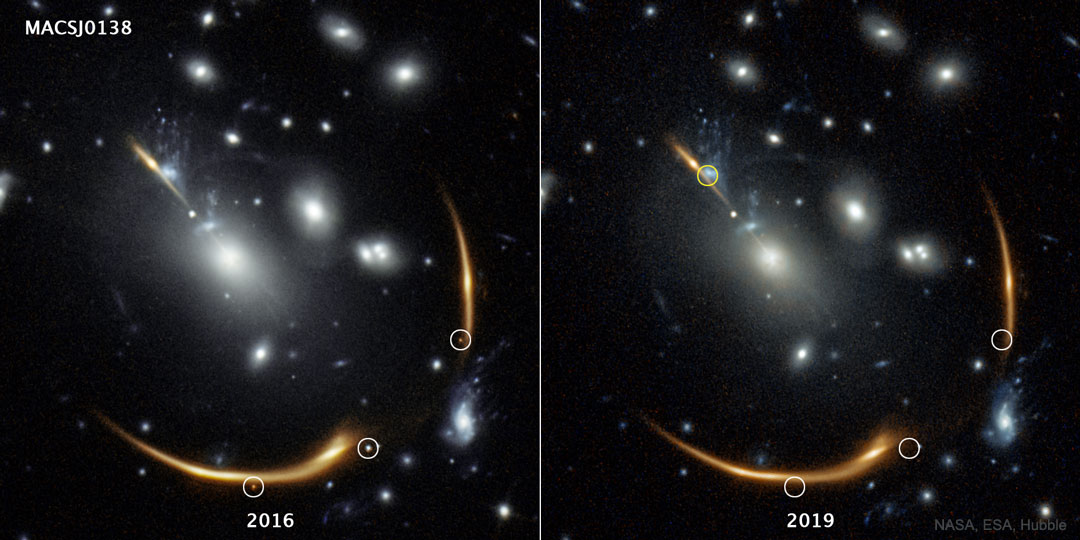
Add To Favorites
We've seen this same supernova three times -- when will we see it a fourth? When a distant star explodes in a supernova, we're lucky if we see it even once. In the case of AT 2016jka ("SN Requiem"), because the exploding star happened to be lined up behind the center of a galaxy cluster (MACS J0138 in this case), a comparison of Hubble Space Telescope images demonstrate that we saw it three times. These three supernova images are highlighted in circles near the bottom of the left frame taken in 2016. On the right frame, taken in 2019, the circles are empty because all three images of the single supernova had faded. Computer modeling of the cluster lens, however, indicates that a fourth image of the same supernova should eventually appear in the upper circle on the right image. But when? The best models predict this will happen in 2037, but this date is uncertain by about two years because of ambiguities in the mass distribution of the cluster lens and the brightness history of the stellar explosion. With refined predictions and vigilant monitoring, Earthlings living 16 years from now may be able to catch this fourth image -- and perhaps learn more about both galaxy clusters and supernovas at once. Discovery + Outreach: Graduate student research position open for APOD
2021-11-02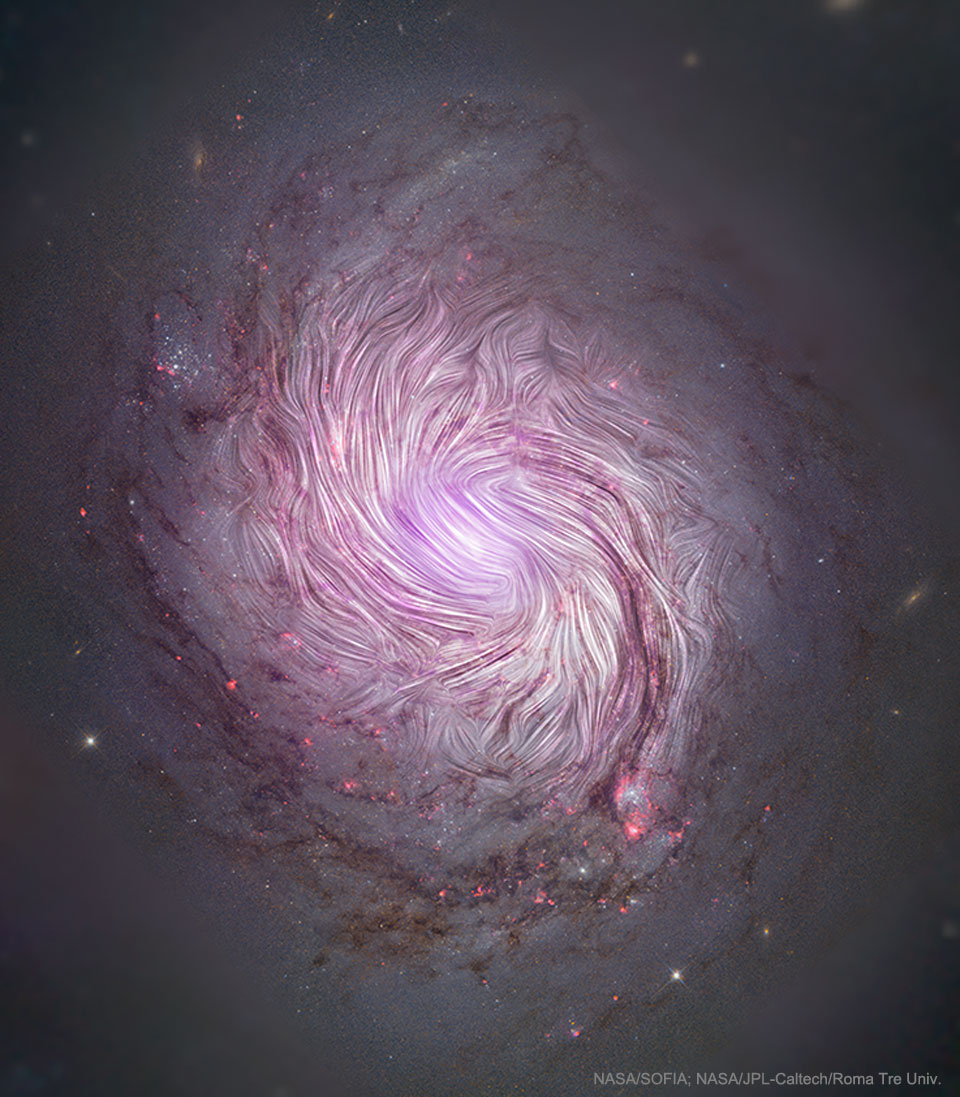
Add To Favorites
Can magnetic fields help tell us how spiral galaxies form and evolve? To find out, the HAWC+ instrument on NASA's airborne (747) SOFIA observatory observed nearby spiral galaxy M77. HAWC+ maps magnetism by observing polarized infrared light emitted by elongated dust grains rotating in alignment with the local magnetic field. The HAWC+ image shows that magnetic fields do appear to trace the spiral arms in the inner regions of M77, arms that likely highlight density waves in the inflowing gas, dust and stars caused by the gravity of the galaxy's oval shape. The featured picture superposes the HAWC+ image over diffuse X-ray emission mapped by NASA's NuSTAR satellite and visible light images taken by Hubble and the SDSS. M77 is located about 47 million light years away toward the constellation of the Sea Monster (Cetus).
2019-12-16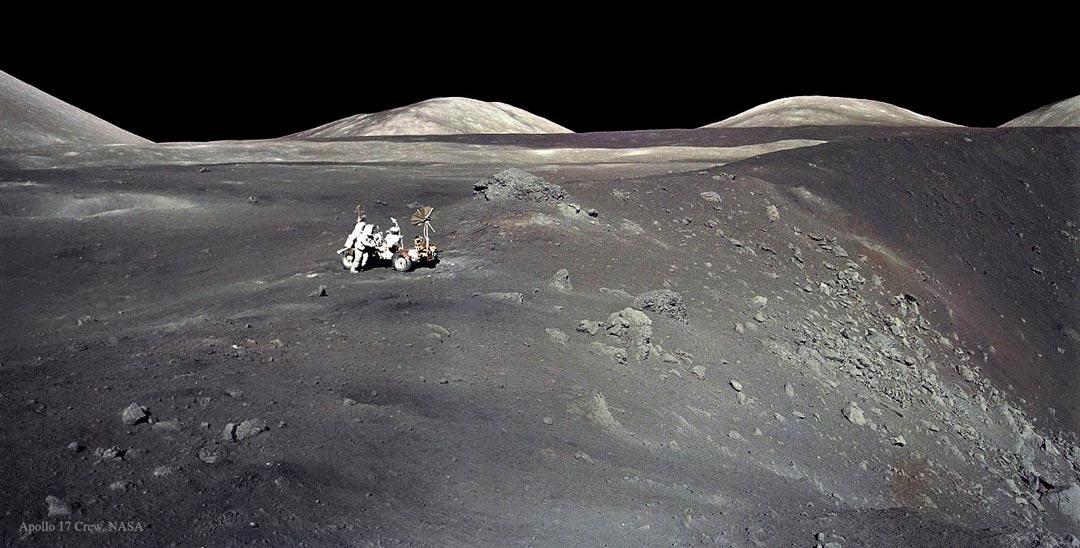
Add To Favorites
On the Moon, it is easy to remember where you parked. In December of 1972, Apollo 17 astronauts Eugene Cernan and Harrison Schmitt spent about 75 hours on the Moon in the Taurus-Littrow valley, while colleague Ronald Evans orbited overhead. This sharp image was taken by Cernan as he and Schmitt roamed the valley floor. The image shows Schmitt on the left with the lunar rover at the edge of Shorty Crater, near the spot where geologist Schmitt discovered orange lunar soil. The Apollo 17 crew returned with 110 kilograms of rock and soil samples, more than was returned from any of the other lunar landing sites. Now forty three years later, Cernan and Schmitt are still the last to walk on the Moon. APOD Editor to Speak: Saturday, August 8 at Keweenaw Science & Engineering Festival
2015-08-02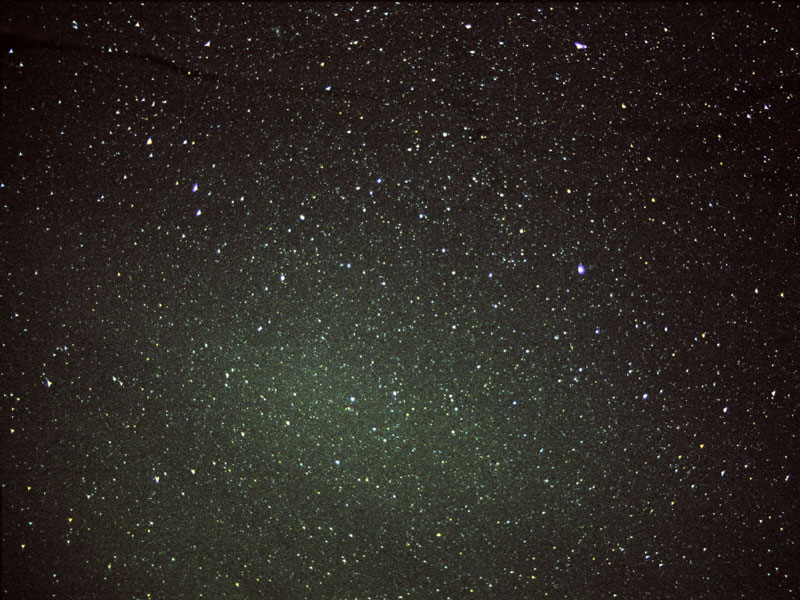
Add To Favorites
If you look carefully enough, you can even see the glow of the Sun in the opposite direction. At night this glow is known as the gegenschein (German for "counter glow"), and can be seen as a faint glow in an extremely dark sky. The gegenschein is sunlight back-scattered off small interplanetary dust particles. These dust particles are millimeter sized splinters from asteroids and orbit in the ecliptic plane of the planets. Pictured above, the gegenschein is seen superposed toward the constellation of Pisces. The gegenschein is distinguished from zodiacal light by the high angle of reflection. During the day, a phenomenon similar to the gegenschein called the glory can be seen in reflecting air or clouds opposite the Sun from an airplane.
2006-12-26Jimmy Westlake (Colorado Mountain College)

Add To Favorites
From July of 1997, a ramp from the Pathfinder lander, the Sojourner robot rover, airbags, a couch, Barnacle Bill and Yogi Rock appear together in this 3D stereo view of the surface of Mars. Barnacle Bill is the rock just left of the solar-paneled Sojourner. Yogi is the big friendly-looking boulder at top right. The "couch" is the angular rock shape visible near center on the horizon. Look at the image with red/blue glasses (or just hold a piece of clear red plastic over your left eye and blue or green over your right) to get the dramatic 3D perspective. The stereo view was recorded by the remarkable Imager for Mars Pathfinder (IMP) camera. The IMP had two optical paths for stereo imaging and ranging and was equipped with an array of color filters for spectral analysis. Operating as the first astronomical observatory on Mars, the IMP also recorded images of the Sun and Deimos, the smallest of Mars' two tiny moons. This July saw the launch of NASA's Mars Perseverance Rover on a mission to the Red Planet.
2020-08-22IMP Team
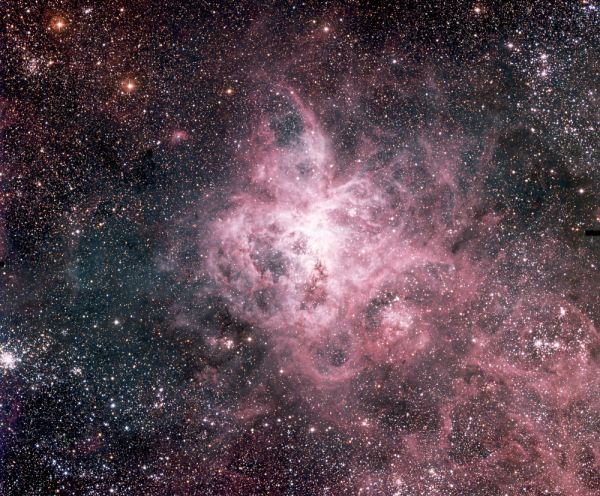
Add To Favorites
The Tarantula Nebula is more than 1,000 light-years across - a giant emission nebula within our neighboring galaxy the Large Magellanic Cloud. Inside this cosmic arachnid lies a central young cluster of massive stars, cataloged as R136, whose intense radiation and strong winds have helped energize the nebular glow and shape the spidery filaments. In this impressive color mosaic of images from the Wide-Field Imager camera on ESO's 2.2 meter telescope at La Silla Observatory, other young star clusters can be seen still within the nebula's grasp. Also notable among the denizens of the Tarantula zone are several dark clouds invading the nebula's outer limits as well as the dense cluster of stars NGC 2100 at the extreme left edge of the picture. The small but expanding remnant of supernova 1987a, the closest supernova in modern history, lies just off the lower right corner of the field. The rich mosaic's field of view covers an area on the sky about the size of the full moon in the southern constellation Dorado.
2002-06-13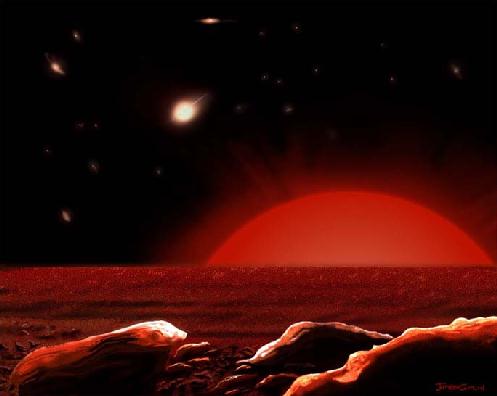
Add To Favorites
Galaxies are made up of stars, but are all stars found within galaxies? Apparently not. Using the Hubble Space Telescope, researchers exploring the Virgo Cluster of galaxies have now found about 600 red giant stars adrift in intergalactic space. Above is an artist's vision of the sky from a hypothetical planet of such a lonely sun. The night sky on a world orbiting an intergalactic star would be a stark contrast to Earth's - which features a nightly parade of stars, all members of our own Milkyway galaxy. As suggested by the illustration, a setting swollen red sun would leave behind a dark sky speckled only with faint, fuzzy, apparitions of Virgo Cluster galaxies. Possibly ejected from their home galaxies during galaxy-galaxy collisions, these isolated suns may well represent part of a large, previously unseen stellar population, filling the the space between Virgo cluster galaxies.
1997-02-03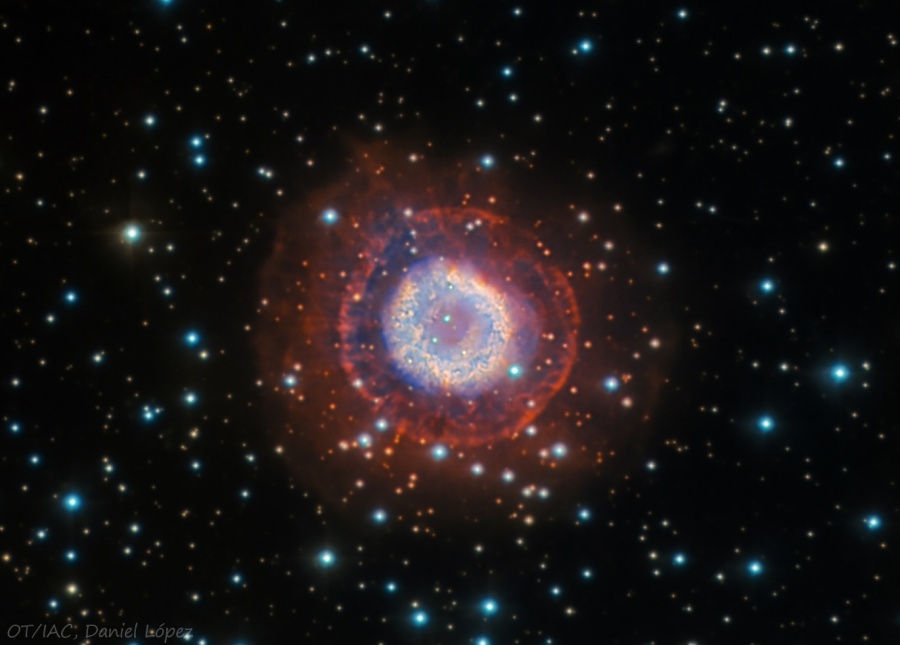
Add To Favorites
NGC 2438 is a planetary nebula, the gaseous shroud cast off by a dying sunlike star billions of years old whose central reservoir of hydrogen fuel has been exhausted. About 3,000 light-years distant it lies within the boundaries of the nautical constellation Puppis. Remarkably, NGC 2438 also seems to lie on the outskirts of bright, relatively young open star cluster M46. But this planetary nebula's central star is not only much older than the stars of M46, it moves through space at a different speed than the cluster stars. Distance estimates also place NGC 2438 closer than M46 and so the nebula appears in the foreground, only by chance along the line-of-sight to the young star cluster. This deep image of NGC 2438 highlights a halo of glowing atomic gas over 4.5 light-years across, extending beyond the nebula's brighter inner ring. Similar haloes have been found in deep images of other planetary nebulae, produced during the earlier active phases of their aging central stars.
2011-04-07Daniel López

Add To Favorites
Yes, but can your aurora do this? First, yes, auroras can look like rainbows even though they are completely different phenomena. Auroras are caused by Sun-created particles being channeled into Earth's atmosphere by Earth's magnetic field, and create colors by exciting atoms at different heights. Conversely, rainbows are created by sunlight backscattering off falling raindrops, and different colors are refracted by slightly different angles. Unfortunately, auroras can’t create waterfalls, but if you plan well and are lucky enough, you can photograph them together. The featured picture is composed of several images taken on the same night last November near the Skógafoss waterfall in Iceland. The planning centered on capturing the central band of our Milky Way galaxy over the picturesque cascade. By luck, a spectacular aurora soon appeared just below the curving arch of the Milky Way. Far in the background, the Pleiades star cluster and the Andromeda galaxy can be found. Your Sky Surprise: What picture did APOD feature on your birthday? (post 1995)
2023-12-27Stefano Pellegrini
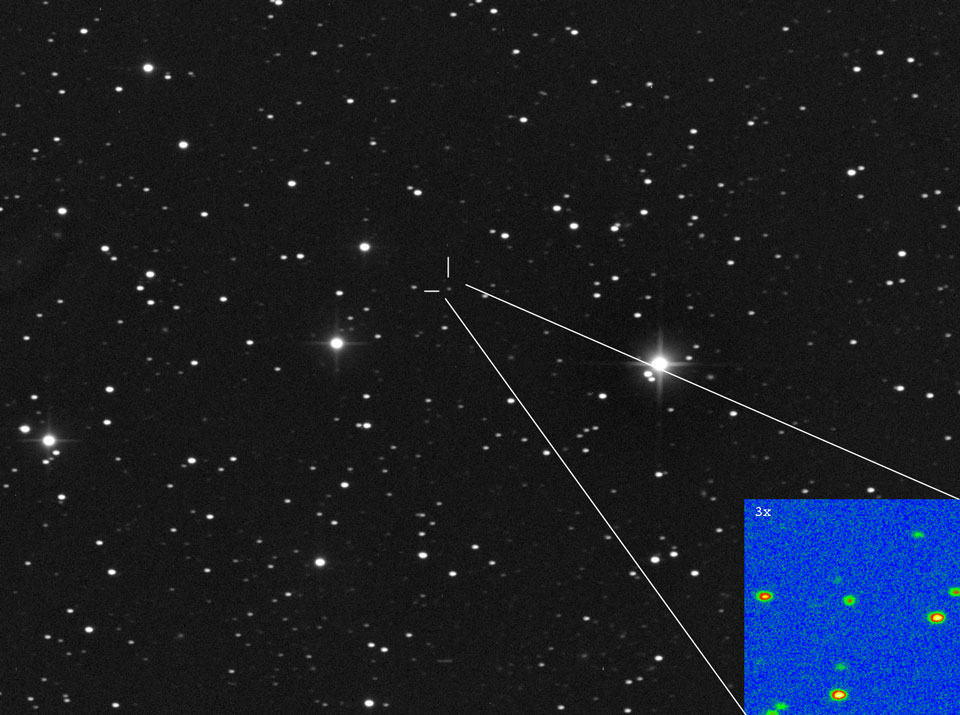
Add To Favorites
Could this dim spot brighten into one of the brightest comets ever? It's possible. Alternatively, the comet could break up when it gets closer to the Sun, or brighten much more modestly. Sky enthusiasts the world over are all abuzz, though, from the more optimistic speculations -- that the newly discovered C/2012 S1 (ISON) could develop a spectacular tail or briefly approach the brightness of the full Moon toward the end of 2013. Comet ISON currently is very faint but is just visible at magnitude 18 in the above image. The comet, discovered just over a week ago from Russia by Vitali Nevski (Belarus) and Artyom Novichonok (Russia), is currently falling toward the Sun from between the orbits of Jupiter and Saturn. In early 2013 October it will pass very near Mars and possibly be visible to rovers and orbiting spacecraft. Comet ISON appears on course to achieve sungrazer status as it passes within a solar diameter of Sun's surface in late 2013 November. Whatever survives will then pass nearest the Earth in late 2013 December. Astronomers around the world will be tracking this large dirty snowball closely to better understand its nature and how it might evolve during the next 15 months.
2012-10-01Ligustri Rolando
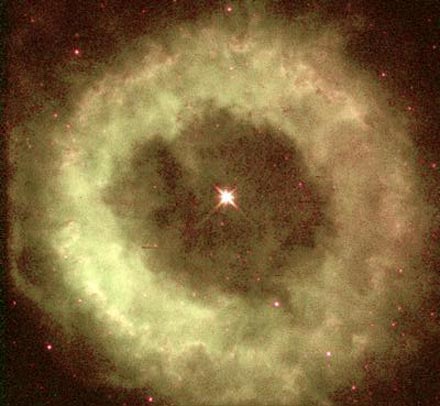
Add To Favorites
Why isn't the star in the center of the nebula? NGC 6369 appears to be a fairly ordinary planetary nebula. It can be seen with a good telescope in the constellation of Ophiuchus. The gas expelled by the central star is bunched in the shape of a donut or cylinder. During the planetary nebula phase, the central star sheds its outer atmosphere as it is evolving to become a white dwarf star. The above image was taken with the Hubble Space Telescope. A closer look at NGC 6369 indicates that the central star is closer to a dimmer edge of the nebula than to the opposing brighter edge.
1998-05-18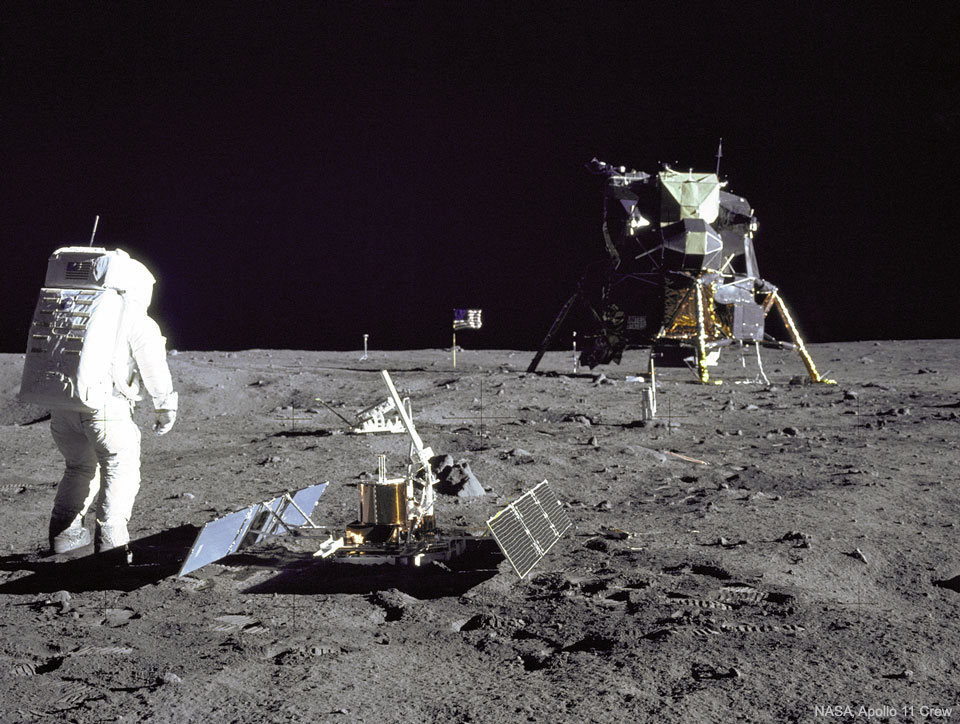
Add To Favorites
Why are there so many moonquakes? Analyses of seismometers left on the moon by the Apollo moon landings reveals a surprising number of moonquakes occurring within 100 kilometers of the surface. In fact, 62 moonquakes were detected in data recorded between 1972 and 1977. Many of these moonquakes are not only strong enough to move furniture in a lunar apartment, but the stiff rock of the moon continues to vibrate for many minutes, significantly longer than the softer rock earthquakes on Earth. The cause of the moonquakes remains unknown, but a leading hypothesis is the collapse of underground faults. Regardless of the source, future moon dwellings need to be built to withstand the frequent shakings. Pictured here 50 years ago today, Apollo 11 astronaut Buzz Aldrin stands beside a recently deployed lunar seismometer, looking back toward the lunar landing module.
2019-07-21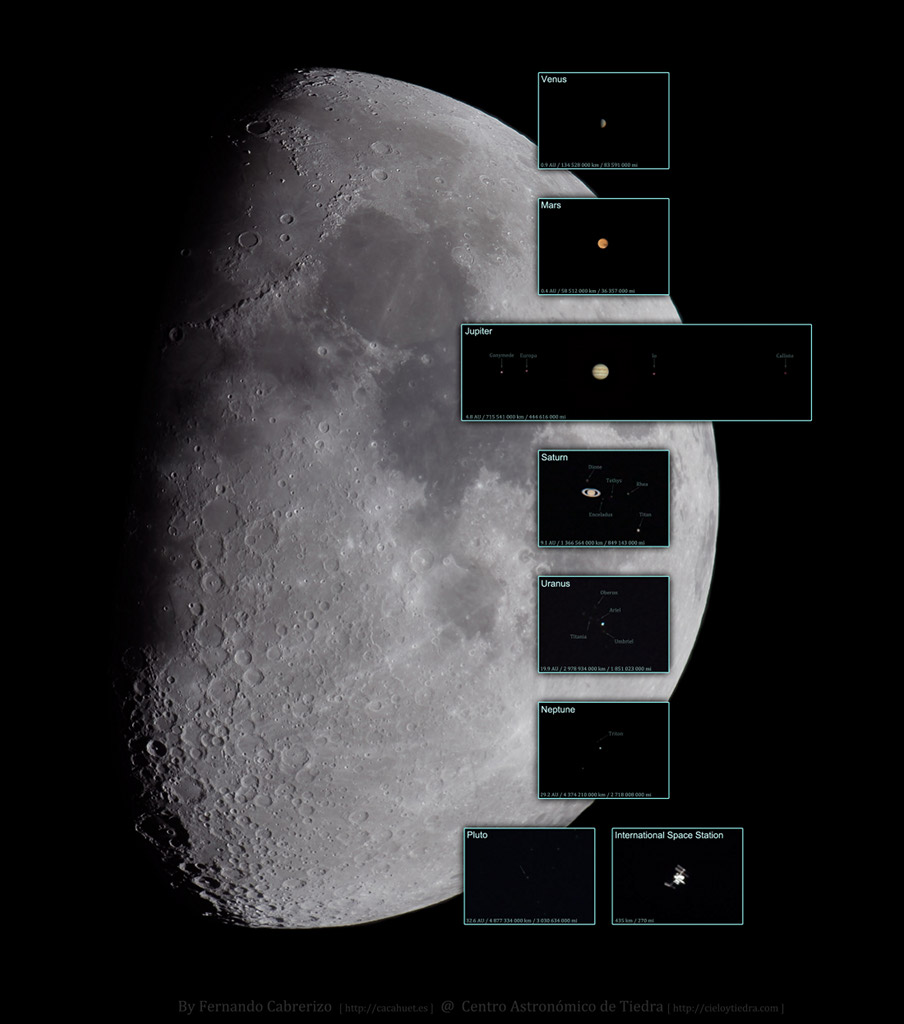
Add To Favorites
Taken on the same night, from the same place, with the same telescope and camera, these postcards from our Solar System are shown at the same scale to provide an interesting comparison of apparent sizes. Spanning about half a degree in planet Earth's sky, the Moon is a stitched mosaic of six images. The others are the result of digitally stacked frames or simple single exposures, with the real distances to the objects indicated along the bottom of each insert. Most of the Solar System's planets with their brighter moons, and Pluto were captured during the telescopic expedition, but elusive Mercury was missed because of clouds near the horizon. The International Space Station was successfully hunted, though. The night was July 21st. Telescope and camera were located at the Centro Astronomico de Tiedra Observatory in Spain. Highlights: Recent Total Lunar Eclipse
2018-07-28Fernando Cabrerizo
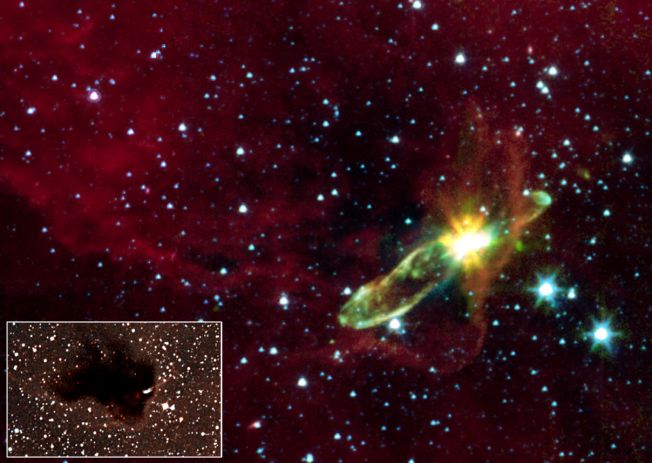
Add To Favorites
High-speed outflows of molecular gas from a young stellar object glow in infrared light, revealing themselves in this recent false-color image from the Spitzer Space Telescope. Cataloged as HH (Herbig-Haro) 46/47 the infrared source is lodged within a dark nebula or Bok globule - near the lower right corner of the dark nebula in the optical inset - that is largely opaque when viewed in visible light. The energetic outflow features extend for nearly a light-year, burrowing into the dark interstellar material, and are attributed to early stages in the life of a sun-like star. They may well represent a phase of our own Sun's evolution which took place some 4.5 billion years ago, along with the formation of our solar system from a circumstellar disk. A tantalizing object to explore with Spitzer's infrared capabilities, this young star system is relatively nearby, located only some 1,140 light-years distant in the nautical constellation Vela.
2003-12-26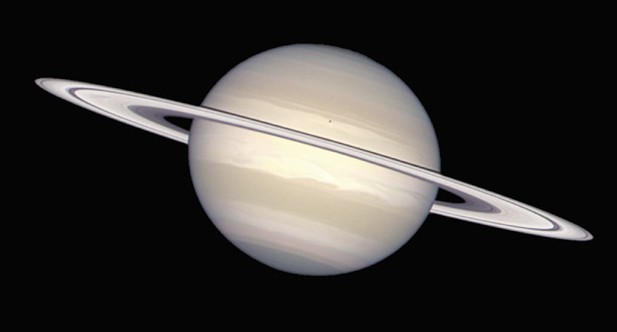
Add To Favorites
What you could see approaching Saturn aboard an interplanetary cruise ship would closely resemble this subtly shaded view of the gorgeous ringed gas giant. Processed by the Hubble Heritage project, the picture intentionally avoids overemphasizing color contrasts and presents a natural looking Saturn with cloud bands, storms, nearly edge-on rings, and the small round shadow of the moon Enceladus near the center of the planet's disk. Of course, seats were not available on the only ship currently enroute - the Cassini spacecraft, launched just over a year ago and scheduled to arrive at Saturn in the year 2004. After an extended cruise to a world 1,400 million kilometers from the Sun, Cassini will tour the Saturnian system, conducting a remote, robotic exploration with software and instruments designed by denizens of planet Earth.
1998-11-05
Add To Favorites
It is the largest asteroid in the asteroid belt -- what secrets does it hold? To find out, NASA has sent the robotic Dawn spacecraft to explore and map this cryptic 1,000-kilometer wide world: Ceres. Orbiting between Mars and Jupiter, Ceres is officially categorized as a dwarf planet but has never been imaged in detail. Featured here is a 20-frame video taken a week ago of Dawn's approach that now rivals even the best images of Ceres ever taken by the Hubble Space Telescope. The video shows enough surface definition to discern its 9-hour rotation period. On target to reach Ceres in early March, Dawn will match speeds and attempt to orbit this previously unexplored body, taking images and data that may help humanity better understand not only the nature and history of Ceres but also the early history of our entire Solar System.
2015-01-20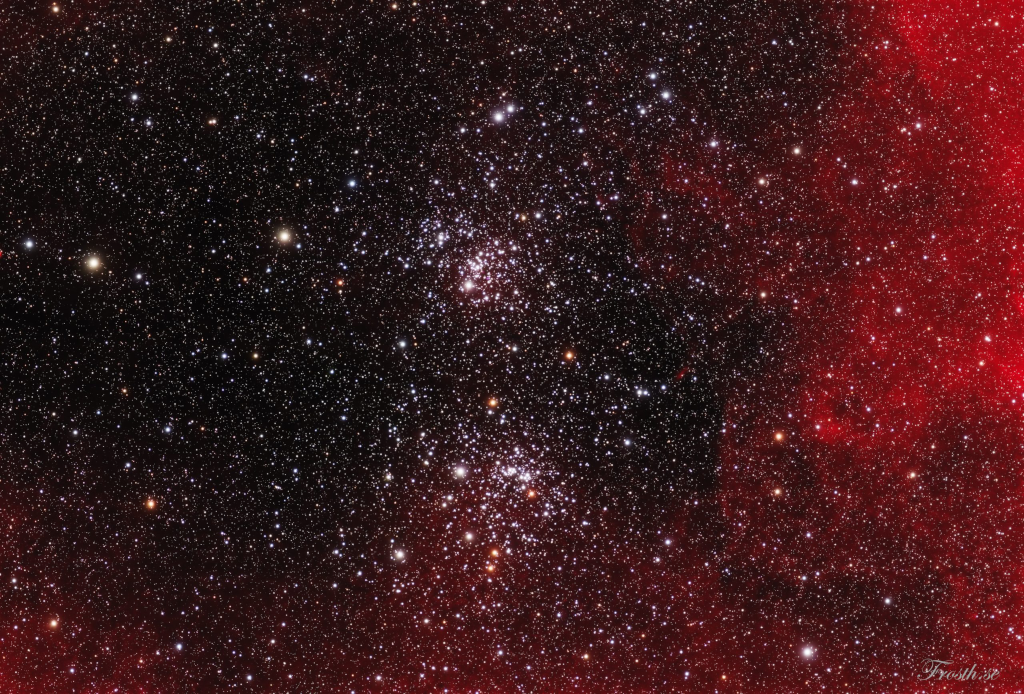
Add To Favorites
This pretty starfield spans about three full moons (1.5 degrees) across the heroic northern constellation of Perseus. It holds the famous pair of open star clusters, h and Chi Persei. Also cataloged as NGC 869 (top) and NGC 884, both clusters are about 7,000 light-years away and contain stars much younger and hotter than the Sun. Separated by only a few hundred light-years, the clusters are both 13 million years young based on the ages of their individual stars, evidence that they were likely a product of the same star-forming region. Always a rewarding sight in binoculars, the Double Cluster is even visible to the unaided eye from dark locations.
2023-07-07Mårten Frosth

Add To Favorites
Slung below its equally innovative mothership dubbed White Knight, SpaceShipOne rides above planet Earth, photographed during a recent flight test. SpaceShipOne was designed and built by cutting-edge aeronautical engineer Burt Rutan and his company Scaled Composites to compete for the X Prize. The 10 million dollar X prize is open to private companies and requires the successful launch of a spaceship which carries three people on short sub-orbital flights to an altitude of 100 kilometers -- a scenario similar to the early manned spaceflights of NASA's Mercury Program. Unlike more conventional rocket flights to space, SpaceShipOne will first be carried to an altitude of 50,000 feet by the twin turbojet White Knight and then released before igniting its own hybrid solid fuel rocket engine. After the climb to space, the craft will convert to a stable high drag configuration for re-entry, ultimately landing like a conventional glider at light plane speeds.
2003-06-27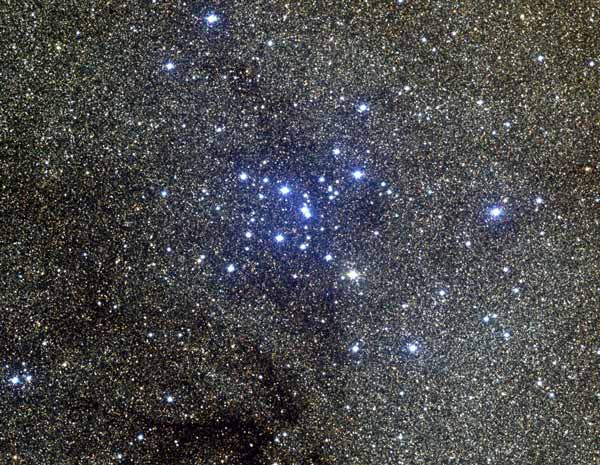
Add To Favorites
M7 is one of the most prominent open clusters of stars on the sky. The cluster, dominated by bright blue stars, can be seen with the naked eye in a dark sky in the tail of the constellation of Scorpius. M7 contains about 100 stars in total, is about 200 million years old, spans 25 light-years across, and lies about 1000 light-years away. This color picture was taken in 1995 at the Burrell-Schmidt Telescope at Kitt Peak National Observatory in Arizona. The M7 star cluster has been known since ancient times, being noted by Ptolemy in the year 130 AD. Also visible is a dark dust cloud near the bottom of the frame, and literally millions of unrelated stars towards the Galactic center.
2000-04-05N. A. Sharp
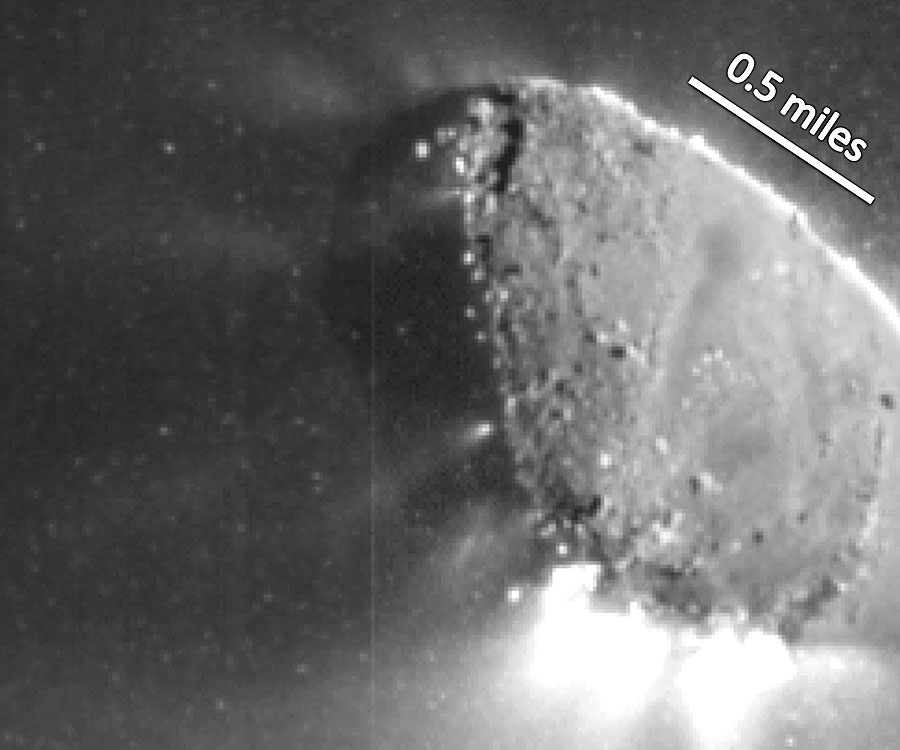
Add To Favorites
Unusual jets have been discovered emanating from Comet Hartley 2. The EPOXI spacecraft imaged the jets in unprecedented detail during its flyby of the comet earlier this month. Pictured above, sun-illuminated jets shoot away from the two-kilometer long decaying iceberg that orbits the Sun between Earth and Jupiter. Comet Hartley 2 became active recently as it neared the Sun and sunlight warmed the comet. Preliminary analyses of images like that shown above indicate that the smooth regions around the middle are porous and leak frozen water vapor directly out into space. Unexpectedly, however, the rough regions at either end appear to shoot carbon dioxide jets that expel fluffy snowballs, some as large as basketballs, from the nucleus. Many of the dots in the above image are thought to be snowballs. The unusual jets will continue to be studied, and may yield further clues as to how comets and asteroids formed and evolved during the early years of our Solar System. Comet Hartley 2 is slowly evaporating and may completely break up over the next 1,000 years.
2010-11-23